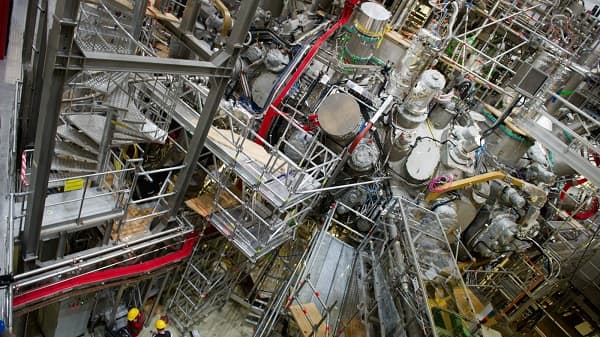German Nuclear Fusion Experiment Brings The Dream of Clean Energy A Step Closer
Scientists in Germany will set the ball rolling for a nuclear fusion reaction which is widely seen as a major breakthrough in the quest for clean and green energy for the generations to come.
Nuclear power is the generation of energy by nuclear fusion. Fusion reactions are high energy reactions where two lighter atomic nuclei fuse to form a heavy nucleus. In the process, some mass is converted to energy in accordance with Einstein’s mass-energy equivalence. Compared with nuclear fission, which produces a high amount of radioactive waste, fusion power is considered to be at harmony with the environment. Interestingly, the sun is a natural fusion reactor.
The experiment at the Max Planck Institute in the Baltic city of Griefswald will convert a tiny amount of injected hydrogen into hydrogen plasma in a stellarator, a doughnut-shaped device that confines hot plasma with magnetic fields in order to sustain a controlled nuclear fusion reaction. Known as the Wendelstein 7-X stellarator, the cutting-edge device was first used in December to heat helium. With hydrogen, the challenges were more.

Most striking of them was the €1.06 billion investment provided by the German government, which is being dismissed by critics as a waste of money. Also, converting hydrogen into plasma requires temperatures as high as 100 million degrees Celsius.
Fortunately, the obstacles have been overcome. Angela Merkel, the German Chancellor will witness the benchmark demonstration that will, for once, produce only plasma and not any energy. However, once accomplished, it will open doors for further research and development in the challenge to obtain nuclear power, which until today has always been tagged “practically unviable†since the reaction consumes more energy than it produces.
The success of the Wendelstein stellarator should also fuel rival projects, including the ITER in France, the Helically Symmetric Experiment (HSX) in the USA and the Large Helical Device in Japan.
Source: German scientists to conduct nuclear fusion experiment | Nuclear power | The Guardian
Nuclear power is the generation of energy by nuclear fusion. Fusion reactions are high energy reactions where two lighter atomic nuclei fuse to form a heavy nucleus. In the process, some mass is converted to energy in accordance with Einstein’s mass-energy equivalence. Compared with nuclear fission, which produces a high amount of radioactive waste, fusion power is considered to be at harmony with the environment. Interestingly, the sun is a natural fusion reactor.
The experiment at the Max Planck Institute in the Baltic city of Griefswald will convert a tiny amount of injected hydrogen into hydrogen plasma in a stellarator, a doughnut-shaped device that confines hot plasma with magnetic fields in order to sustain a controlled nuclear fusion reaction. Known as the Wendelstein 7-X stellarator, the cutting-edge device was first used in December to heat helium. With hydrogen, the challenges were more.

Most striking of them was the €1.06 billion investment provided by the German government, which is being dismissed by critics as a waste of money. Also, converting hydrogen into plasma requires temperatures as high as 100 million degrees Celsius.
Fortunately, the obstacles have been overcome. Angela Merkel, the German Chancellor will witness the benchmark demonstration that will, for once, produce only plasma and not any energy. However, once accomplished, it will open doors for further research and development in the challenge to obtain nuclear power, which until today has always been tagged “practically unviable†since the reaction consumes more energy than it produces.
The success of the Wendelstein stellarator should also fuel rival projects, including the ITER in France, the Helically Symmetric Experiment (HSX) in the USA and the Large Helical Device in Japan.
Source: German scientists to conduct nuclear fusion experiment | Nuclear power | The Guardian
Replies
You are reading an archived discussion.
Related Posts
DESIGN AND ANALYSIS OF SPACE SHUTTLE NOZZLE
ABSTRACT: The function of a rocket nozzle is to channelise and accelerate the combustion products produced by the burning propellant, inside a rocket...
I'm very much interested to learn hfss and do antenna simulations. anyone please help me
Hi all ,
I am inviting ideas and opportunities on development of organic solar cell(PV Cells) production/research /design in Indian subcontinent for cheap availability of power in rural india.
All...
BMW is a part of Make in India program, and has launched its brand new luxury 7 series limousine at the 13th Auto Expo. Brand Ambassador of BMW, ace cricket...
In a very swift move, the US tech giant Microsoft has announced the acquisition of the firm SwiftKey known for its advanced, AI-powered smart prediction technology that makes typing easier....
